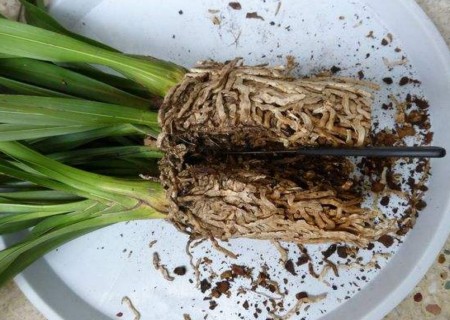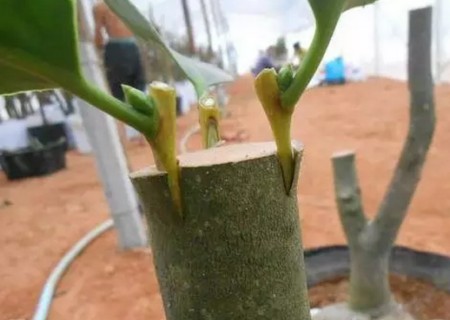Illustration of grafting method of potted Camellia
Camellia belongs to the tree species difficult to survive grafting, in order to improve the survival rate of grafting, on the one hand, we must master the grafting operation skills, on the other hand, we must use some special grafting methods. According to the variety of resources for scion selection, and then from the operator's personal preferences for a reasonable mix, so that the grafted camellia to achieve the desired effect.
Scion should be selected fine clones and crown, upper peripheral branches. Camellia should be selected to grow strong varieties of trees, full axillary buds, normal leaf color, no pests and diseases branches. Spring shoots of the current year are used in summer, and spring shoots or summer shoots of the current year are used as scions in autumn. Collect in the morning and place in a basin or cup filled with water to avoid dehydration and dryness. Scion is good with pick with next, avoid taking shade branch, old branch and disease branch.

I only started to contact camellia last year, that is, I started camellia grafting last year. The grafting method used was copied from Zhejiang Jinhua Master, and even the grafting knife was bought from them or given by friends. The purpose of today's post is to throw a brick to attract jade, discuss our grafting methods and techniques together, and achieve the goal of learning from each other and improving each other.
This is a grafting knife, polished with sub-hacksaw. Maybe some friends who haven't seen it think its shape is strange. In fact, every bend and angle of the knife edge contain mechanical, convenient and practical functions. Ha ha, this topic will not say more, say more you want to say that I am selling knives! I believe that friends have the opportunity to know its rationality in practical application.
1. Saw rootstock
Whatever rootstock is used for camellia grafting must remain relatively viable. This can be distinguished from the new cut of the rootstock, which requires the section to be moist and fresh without black heart and rust. Experienced masters will distinguish sawdust according to its color, humidity and feel when sawing, without sawing.
This is the sawn section, and you can see that there's a watery feel to it. Fig. 2, 3. There are some problems in the cross section, so we saw it again. In addition, in the initial pile cutting, saw cut in the maintenance of good healing can be directly grafted.
2. Defoliation
Although camellia leaves are stiffer, but there is no sharp knife and method, always tear the leaves. Here in fact to master is under the knife edge and blade nearly parallel, and then use the knife edge pull cut. Instead of direct knife edge and leaf surface into a cross cut. After each leaf is shaved, the scion can be shaved.
3. Cutting of scion
The first knife is to cut from one side of scion leaves, so that the lower part of leaves is thick and the opposite side is thin, and a slope is cut down horizontally like cutting leaves, which is required to be smooth and smooth.
The second knife is to turn the scion upside down, cutting the back of the first knife and making it wedge shaped.
The third knife cuts off the phloem of the branches opposite the leaves, exposing the cambium for later healing.
The fourth cut is to cut off the raw edges so that the scion can be inserted into the rootstock incision, and also for faster healing later.
After the scion is cut, hold the branches and scion leaves with your left hand, and cut off the scion with a knife in your right hand 5 mm above the scion bud point. This requires a good grasp of the strength and length of the knife, otherwise it will be too light and too short to cut, or cut off the bud and petiole.
4. Rootstock incision:
According to the rootstock trunk vertical knife, according to the length of scion depends on the height of the knife edge, the upper (near the section surface) knife edge cut inward, with a little xylem. The incision is an inverted right triangle. Ask for smoothing.
The number of xylem cut, generally after the knife into the release, grafting knife will not fall off the best, of course, can not cut too much xylem, that will damage the semi-lignified scion, not only wasted effort increased the risk of sliding knife also makes scion insertion increased difficulties.
For bonsai or other plants that need to be supplemented in the middle of the rootstock, the method of abdominal grafting is adopted:
Then it is to wrap the incision with tape to fix the scion, bagging moisture and so on.
In fact, grafting success or failure, grafting methods only account for a small proportion. The key is the vitality of rootstock, scion vigor, grafting environment and conservation level.
Time: 2019-06-10 Click:
- Prev

Ramet method of Cymbidium grandiflorum
Cymbidium has many varieties, large petals, bright colors and many colors, such as red, yellow, green, white, pink, purple and various transitional and compound colors, the flower stem is erect and firm, the florescence is long, and it can be used as a pot or fresh cut flower. It is deeply loved by the majority of flower friends and has become one of the most widely cultivated Cymbidium in the world. According to the routine
- Next

Grafting method of potted Camellia
Put a few pots of camellias in the bedroom, can decorate the environment more elegant, in order to increase the interest of life. Potted camellias will have higher ornamental value if they are modeled and planted in a suitable bonsai. Camellia belongs to the tree species that are difficult to survive by grafting, so it is necessary to improve the survival rate of grafting.
Related
- Fuxing push coffee new agricultural production and marketing class: lack of small-scale processing plants
- Jujube rice field leisure farm deep ploughing Yilan for five years to create a space for organic food and play
- Nongyu Farm-A trial of organic papaya for brave women with advanced technology
- Four points for attention in the prevention and control of diseases and insect pests of edible fungi
- How to add nutrient solution to Edible Fungi
- Is there any good way to control edible fungus mites?
- Open Inoculation Technology of Edible Fungi
- Is there any clever way to use fertilizer for edible fungus in winter?
- What agents are used to kill the pathogens of edible fungi in the mushroom shed?
- Rapid drying of Edible Fungi

